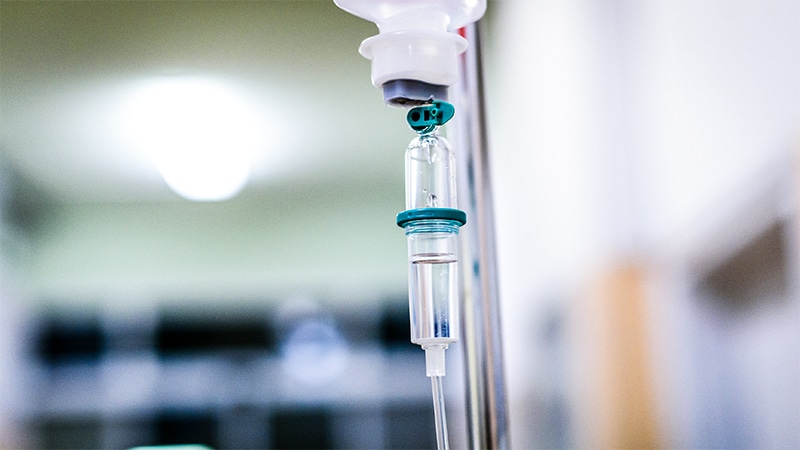[ad_1]
New research provides further evidence that thrombolysis benefits select patients with acute ischemic stroke up to 24 hours after symptom onset.
In the HOPE trial, administration of intravenous (IV) alteplase between 4.5 and 24.0 hours after stroke onset in patients with imaging-confirmed salvageable brain tissue resulted in a greater proportion of patients having a nondisabled functional outcome than did standard medical treatment.
Although there was an increase in symptomatic intracranial hemorrhage in the thrombolysis group, this did not lead to a difference in mortality.
The trial included patients with stroke caused by either large vessel occlusion or distal-medium vessel occlusion who were not planned to receive endovascular therapy.
“Our results add to other recent data that support extending the therapeutic window for IV thrombolysis in acute ischemic stroke patients if endovascular thrombectomy is not available or indicated,” concluded lead investigator, Min Lou, MD, from the Second Affiliated Hospital of Zhejiang University’s School of Medicine in Hangzhou, China.
“We believe these findings mean more people may return to normal or near-normal lives after a stroke, even if they receive treatment later than originally thought beneficial,” Lou said.
“This method of treatment could become the new standard, especially in hospitals that use CT perfusion imaging. This could extend treatment eligibility to millions more patients across the globe, particularly in regions that lack access to endovascular thrombectomy,” she added.
The findings were presented on February 7 at the International Stroke Conference (ISC) 2025.
Time to Extend Treatment Window?
In the United States, thrombolysis is recommended to be given to acute ischemic stroke patients up to 4.5 hours of stroke onset.
“Intravenous thrombolysis is the cornerstone of ischemic stroke reperfusion therapy. But the therapeutic window of 4.5 hours limits its use,” Lou said.
For many years it has been thought too dangerous to extend the time window for thrombolysis because of the high risk for ICH outweighing any benefit. But more recent trials have shown some success in the later time window by selecting patients for thrombolysis treatment by using advanced imaging techniques to identify those with salvageable brain tissue.
In 2019, the EXTEND trial showed a benefit of alteplase up to 9 hours using this approach. And then last year the Chinese TRACE-III trial showed benefit of IV tenecteplase up to 24 hours after symptom onset in patients in stroke patients with l arge vessel occlusion and tissue at risk for infarction who were unable to receive endovascular therapy.
Another US trial (TIMELESS) failed to show a benefit of tenecteplase given later than 4.5 hours in patients with large vessel occlusion stroke but in this trial most patients received thrombectomy which may have negated the need for thrombolysis.
The HOPE trial included 372 stroke patients who presented 4.5 hours to 24.0 hours from symptom onset and who had salvageable brain tissue as identified on CT perfusion imaging.
They were randomly assigned to receive IV thrombolysis with alteplase or standard stroke care of antiplatelet therapy at the discretion of the investigator (control group). Less than 3% of participants in either group received rescue mechanical clot removal as an additional treatment.
The primary endpoint was a favorable outcome — a modified Rankin scale score of 0-1 at 90 days.
This occurred in 40.3% of alteplase treated patients vs 26.3% of those in the control group, giving more than a 50% higher chance of functional recovery (relative risk, 1.52; 95% CI, 1.14-2.02; P = .004).
Safety death showed that ICH was increased in the alteplase group occurring in 3.8% of patients vs 0.5% in the control group. But the mortality rate was not increased, with 10.8% of patients in each group having died by 90 days.
Lou listed strengths of the HOPE trial as having less restrictive enrolment criteria than previous studies, including both large vessel and distal occlusion stroke patients, and more flexible mismatch criteria used to define salvageable brain tissue. It also allowed the use of many different types of CT perfusion software so was closer to real-world clinical practices than previous trials.
Limitations included an open label design, although outcome assessments were conducted by evaluators who were blinded to treatment assignments; the suggestion that the findings may not be generalizable to patients with large vessel occlusion who present directly to thrombectomy-capable centers or to other populations outside China.
Patient Selection Is Key
Commenting on the findings for Medscape Medical News, Lauren Sansing, MD, Yale University, New Haven, Connecticut, chair of the ISC 2025 meeting, said she was not surprised by the results.
“We have seen in previous studies that if we select the right patents with advanced imagining techniques then IV thrombolysis can show benefits in the later time window. This is one more step in that story. But these studies have been done predominantly in Asian patients, and it would be good to see more data in different populations. There will be more trials coming on this in the next few years.”
The HOPE trial was sponsored by the Second Affiliated Hospital, School of Medicine, Zhejiang University. Lou reported no disclosures.
[ad_2]
Source link : https://www.medscape.com/viewarticle/more-evidence-supports-later-thrombolysis-ischemic-stroke-2025a10003jm?src=rss
Author :
Publish date : 2025-02-11 13:13:54
Copyright for syndicated content belongs to the linked Source.
